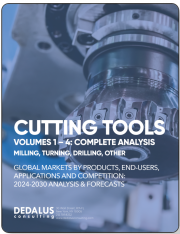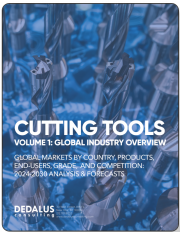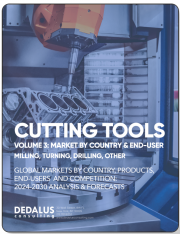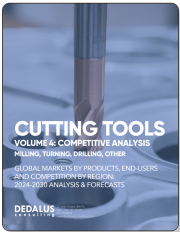
|
시장보고서
상품코드
1662776
절삭 공구 시장 예측 : 유형별, 재료별, 공구 코팅별, 기계 유형별, 판매 채널별, 용도별, 지역별 세계 분석(-2030)Cutting Tool Market Forecasts to 2030 - Global Analysis By Type (Non-Rotary Cutting Tools, Rotary Cutting Tools, Solid Round Tools, Indexable Inserts, and Other Types), Material, Tool Coating, Machine Type, Sales Channel, Application and By Geography |
||||||
Stratistics MRC에 따르면 세계의 절삭 공구 시장은 2024년에 250억 4,000만 달러를 차지했고 예측 기간 동안 CAGR은 8.2%를 나타낼 것으로 추정되며 2030년에는 401억 9,000만 달러에 이를 전망입니다.
절삭 공구는 전단 변형에 의해 피삭재로부터 재료를 제거하는 기계 가공 공정에 사용되는 특수 공구입니다. 이 공구는 일반적으로 높은 속도와 마모를 견딜 수 있도록 고속 강, 초경합금, 세라믹과 같은 경질 재료로 만들어집니다. 절삭 공구에는 드릴, 밀링, 선반, 톱 등 다양한 형태가 있으며, 제조업, 자동차, 항공우주 등의 산업에서 정밀하고 고품질의 부품을 제조하는데 필수적입니다. 그 성능과 내구성은 기계 가공 작업의 효율과 정확성에 크게 영향을 미칩니다.
산업화 및 생산 활동 확대
산업이 확대되고 현대화됨에 따라 생산 효율과 정밀도를 높이기 위한 선진 절삭 공구에 대한 수요가 증가하고 있습니다. 자동화 시스템에는 신뢰성이 높고 고성능의 절삭 공구가 필요하기 때문에 제조 공정의 자동화가 진행되고 있는 것도 이 수요에 기여하고 있습니다. 또한 자동차, 항공우주, 건설 등의 부문에서는 생산량이 급증하고 절삭 공구의 요구가 더욱 높아지고 있습니다. 제조업에서의 신재료와 복합재료의 지속적인 개발에는 다양한 재료를 다루는 선진적 절삭 공구가 필요합니다.
원료 가격 변동
강철, 코발트, 텅스텐 등 절삭 공구 제조에 필요한 원료의 가격은 크게 변동합니다. 제조업체의 전체 제조 비용은 이러한 가격 변동의 영향을 받아 가격 및 이익률에 영향을 줄 수 있습니다. 또한, 원료의 가격 변동으로 인한 공급망의 중단은 생산 및 납기 지연으로 이어질 수 있습니다. 이러한 변동을 줄이기 위해 제조업체는 장기 계약 및 대체 재료 조달과 같은 계획을 수행해야합니다.
에너지 효율적인 제조에 대한 관심 증가
산업은 항상 생산 공정을 더욱 지속 가능하게 만들고 에너지 사용을 줄이는 방법을 모색하고 있습니다. 낭비를 없애고 정확도를 향상시킴으로써 에너지 효율적인 절삭 공구는 이러한 목적을 달성하는 데 매우 중요한 역할을합니다. 에너지 소비는 코팅 및 형태를 개선한 공구의 개발과 같은 절삭 공구 기술의 발전으로 감소됩니다. 첨단 절삭 공구의 채택은 에너지 효율적인 실천을 장려하는 정부의 장려책과 법률에 의해 촉진됩니다.
비절삭 방법에 의한 대체
레이저 커팅, 워터젯 커팅, 라미네이션 모델링(3D 프린팅)과 같은 비절삭 기술을 통한 종래의 절삭 방법의 대안은 절삭 공구 시장에 도전을 제기하고 있습니다. 이러한 대체 기술은 종종 더 높은 정밀도, 더 빠른 가공 시간, 복잡한 형태 및 재료를 처리할 수 있는 능력을 제공하여 전통적인 절삭 공구의 필요성을 줄입니다. 비용 효율성과 범용성이 높기 때문에 이러한 비절삭 방식을 채용하는 산업이 늘어나면서, 특히 비절삭 기술이 보다 효율적인 용도에서는 종래의 절삭 공구 수요가 감소할 가능성이 있습니다.
COVID-19의 영향
COVID-19의 유행은 절삭 공구 시장에 큰 영향을 미치고 공급망과 제조 공정에 큰 혼란을 초래했습니다. 많은 제조업체들이 생산 정지나 노동력 부족에 직면하여 절삭 공구의 납품 지연으로 이어졌습니다. 게다가 유행기간 동안 경제 불안과 산업 활동 저하로 절삭 공구 수요가 감소했습니다. 그러나 산업이 점차 회복되고 운영을 재개함에 따라 시장 회복이 예상됩니다. 팬데믹은 또한 자동화와 디지털화의 도입을 가속화하고 이러한 기술에 대응하는 첨단 절삭 공구의 필요성을 촉진했습니다.
예측 기간 동안 회전 절삭 공구 부문이 최대가 될 전망
회전 절삭 공구 부문은 예측 기간 동안 최대 시장 점유율을 차지할 것으로 예상됩니다. 그 이유는 정밀하고 효율적인 절삭 작업을 수행하는 능력 때문에 대량 생산 환경에서 필수적이기 때문입니다. 또한, 회전 절삭 공구의 설계와 재료의 진보는 성능과 수명을 향상시키고 채택을 더욱 촉진하고 있습니다. 특정 용도에 특화된 회전 절삭 공구의 지속적인 기술 혁신과 개발도 시장 확대에 기여하고 있습니다.
예측 기간 동안 금속 가공 부문의 CAGR이 가장 높을 것으로 예상
예측 기간 동안, 금속 가공 부문은 다양한 산업에서 정밀 가공의 요구가 증가함에 따라 가장 높은 성장률을 나타낼 것으로 예측됩니다. 금속 가공에는 밀링, 선반 가공, 연삭 가공 등의 공정이 포함되며, 이러한 공정에서는 원하는 정밀도와 표면 마감을 달성하기 위해 고성능 절삭 공구가 필요합니다. 특히 자동차 및 항공우주산업은 품질 요건이 엄격하기 때문에 첨단 금속가공 공구 수요를 견인하고 있습니다. Industry 4.0과 스마트 매뉴팩처링의 대두도 실시간 모니터링과 최적화를 목적으로 하는 금속 가공에 있어서의 절삭 공구의 채용을 뒷받침하고 있습니다.
최대 점유율 지역
예측 기간 동안 중국, 일본, 인도 등 국가에 주요 제조 거점이 존재하기 때문에 아시아태평양이 최대 시장 점유율을 차지할 것으로 예상됩니다. 이 지역은 자동차, 항공우주, 일렉트로닉스 산업이 활발해 절삭 공구 수요를 견인하고 있습니다. 또한 인프라 개발에 대한 투자 증가와 제조업 확대도 시장 성장에 기여하고 있습니다. 숙련 노동자 확보와 제조 기술의 진보는 이 지역 시장 지위를 더욱 높여주고 있습니다.
CAGR이 가장 높은 지역
예측 기간 동안 북미가 가장 높은 CAGR을 나타낼 것으로 예측되며, 이는 기술의 진보와 제조 활동의 부활이 원동력이 되고 있습니다. 특히 미국에서는 제조업무의 재위탁에 중점을 두는 경향이 강해지고 있으며, 이것이 절삭 공구 수요를 밀어 올리고 있습니다. 이 지역이 기술 혁신에 주력하고, 적층조형이나 자동화 등의 선진적 제조기술을 개발하고 있는 것도 시장의 성장에 기여하고 있습니다. 또한 주요 산업 진출기업의 존재와 연구 개발에 대한 많은 투자가 북미에서 절삭 공구 시장의 확대를 더욱 강화하고 있습니다.
사용자 정의 무료 제공
이 보고서를 구독하는 고객은 다음 무료 맞춤설정 옵션 중 하나를 사용할 수 있습니다.
- 기업 프로파일
- 추가 시장 진출기업의 종합적 프로파일링(3개사까지)
- 주요 기업의 SWOT 분석(3개사까지)
- 지역 세분화
- 고객의 관심에 응한 주요국 시장 추정, 예측, CAGR(주 : 타당성 확인에 따름)
- 경쟁 벤치마킹
- 제품 포트폴리오, 지리적 존재, 전략적 제휴를 통한 주요 기업 벤치마킹
목차
제1장 주요 요약
제2장 서문
- 개요
- 이해관계자
- 조사 범위
- 조사 방법
- 데이터 마이닝
- 데이터 분석
- 데이터 검증
- 조사 접근
- 조사 정보원
- 1차 조사 정보원
- 2차 조사 정보원
- 전제조건
제3장 시장 동향 분석
- 서론
- 성장 촉진요인
- 성장 억제요인
- 기회
- 위협
- 용도 분석
- 신흥 시장
- COVID-19의 영향
제4장 Porter's Five Forces 분석
- 공급기업의 협상력
- 구매자의 협상력
- 대체품의 위협
- 신규 참가업체의 위협
- 경쟁 기업 간 경쟁 관계
제5장 세계의 절삭 공구 시장 : 유형별
- 서론
- 비로터리 절삭 공구
- 로터리 절삭 공구
- 솔리드 원형 공구
- 인덱서블 인서트
- 기타
제6장 세계의 절삭 공구 시장 : 재료별
- 서론
- 고속강(HSS)
- 텅스텐 카바이드
- 세라믹
- 입방정 질화 붕소(CBN)
- 다결정 다이아몬드(PCD)
- 코팅 도구
- 이색 재료
- 탄소강
- 서멧
- 다이아몬드
- 기타
제7장 세계의 절삭 공구 시장 : 공구 코팅별
- 서론
- 코팅 없음
- 코팅
- PVD 코팅
- CVD 코팅
제8장 세계의 절삭 공구 시장 : 기계 유형별
- 서론
- 수공구
- 벤치톱
- 독립형 공작 기계
- 수동 공작 기계
- CNC 공작 기계
- 머시닝 센터
- 기타
제9장 세계의 절삭 공구 시장 : 유통 채널별
- 서론
- 판매자와 소매업체
- 직접 판매
제10장 세계의 절삭 공구 시장 : 용도별
- 서론
- 항공우주
- 자동차
- 건설
- 금속가공
- 일렉트로닉스
- 에너지와 발전
- 석유 및 가스
- 기타
제11장 세계의 절삭 공구 시장 : 지역별
- 서론
- 북미
- 미국
- 캐나다
- 멕시코
- 유럽
- 독일
- 영국
- 이탈리아
- 프랑스
- 스페인
- 기타 유럽
- 아시아태평양
- 일본
- 중국
- 인도
- 호주
- 뉴질랜드
- 한국
- 기타 아시아태평양
- 남미
- 아르헨티나
- 브라질
- 칠레
- 기타 남미
- 중동 및 아프리카
- 사우디아라비아
- 아랍에미리트(UAE)
- 카타르
- 남아프리카
- 기타 중동 및 아프리카
제12장 주요 개발
- 계약, 파트너십, 협업, 합작 투자
- 인수와 합병
- 신제품 발매
- 사업 확대
- 기타 주요 전략
제13장 기업 프로파일링
- Sandvik Coromant
- Kennametal Inc.
- Seco Tools
- Mitsubishi Materials Corporation
- Kyocera Corporation
- Ceratizit Group
- Iscar Metalworking
- Guhring GmbH
- Sumitomo Electric Industries
- Walter AG
- Toolmex Industrial Solutions
- Tungaloy Corporation
- LMT Tools
- Mapal Dr. Kress KG
- Bohler Uddeholm
According to Stratistics MRC, the Global Cutting Tool Market is accounted for $25.04 billion in 2024 and is expected to reach $40.19 billion by 2030 growing at a CAGR of 8.2% during the forecast period. A cutting tool is a specialized tool used in machining processes to remove material from a work piece through shear deformation. These tools are typically made from hard materials like high-speed steel, carbide, or ceramics to withstand high temperatures and wear. Cutting tools come in various forms, such as drills, mills, lathes, and saws, and are essential in industries like manufacturing, automotive, and aerospace for producing precise, high-quality parts. Their performance and durability significantly impact the efficiency and accuracy of machining operations.
Market Dynamics:
Driver:
Growing industrialization and manufacturing activities
As industries expand and modernize, the demand for advanced cutting tools rises to enhance production efficiency and precision. Increased automation in manufacturing processes also contributes to this demand, as automated systems require reliable and high-performance cutting tools. Furthermore, sectors such as automotive, aerospace, and construction are witnessing a surge in production, further boosting the need for cutting tools. The continuous development of new materials and composites in manufacturing necessitates advanced cutting tools capable of handling diverse materials.
Restraint:
Raw material price fluctuations
The price of raw materials that are necessary for the production of cutting tools, like steel, cobalt, and tungsten, can vary greatly. Manufacturers' entire manufacturing costs may be impacted by these price swings, which may have an effect on pricing and profit margins. Furthermore, supply chain interruptions brought on by price volatility for raw materials may result in production and delivery delays. To lessen these fluctuations, manufacturers must implement plans like long-term agreements or alternate material procurement.
Opportunity:
Rising focus on energy-efficient manufacturing
Industries are always looking for methods to make their production processes more sustainable and use less energy. By reducing waste and improving accuracy, energy-efficient cutting tools can be extremely important in accomplishing these objectives. Energy consumption is decreased via advancements in cutting tool technology, such as the creation of tools with improved coatings and geometry. The adoption of sophisticated cutting tools is also fuelled by government incentives and laws that encourage energy-efficient practices.
Threat:
Substitution by non-cutting methods
The substitution of traditional cutting methods by non-cutting technologies, such as laser cutting, water jet cutting, and additive manufacturing (3D printing), poses a challenge to the cutting tool market. These alternatives often provide higher precision, faster processing times, and the ability to work with complex shapes and materials, reducing the need for conventional cutting tools. As industries increasingly adopt these non-cutting methods for their cost-effectiveness and versatility, the demand for traditional cutting tools may decline, especially in applications where non-cutting technologies are more efficient.
Covid-19 Impact
The COVID-19 pandemic has had a profound impact on the cutting tool market, causing significant disruptions in the supply chain and manufacturing processes. Many manufacturers faced production halts and labor shortages, leading to delays in the delivery of cutting tools. Additionally, the economic uncertainty and reduced industrial activities during the pandemic period resulted in decreased demand for cutting tools. However, as industries gradually recover and resume operations, there is an expected rebound in the market. The pandemic has also accelerated the adoption of automation and digitalization, driving the need for advanced cutting tools compatible with these technologies.
The rotary cutting tools segment is expected to be the largest during the forecast period
The rotary cutting tools segment is expected to account for the largest market share during the forecast period, due to their ability to perform precise and efficient cutting operations makes them indispensable in high-volume production environments. Additionally, advancements in rotary cutting tool designs and materials enhance their performance and longevity, further driving their adoption. The continuous innovation and development of specialized rotary cutting tools for specific applications also contribute to their market expansion.
The metalworking segment is expected to have the highest CAGR during the forecast period
Over the forecast period, the metalworking segment is predicted to witness the highest growth rate, due to the rising need for precision machining in various industries. Metalworking involves processes such as milling, turning, and grinding, which require high-performance cutting tools to achieve the desired accuracy and surface finish. The automotive and aerospace sectors, in particular, are driving the demand for advanced metalworking tools due to their stringent quality requirements. The rise of Industry 4.0 and smart manufacturing is also boosting the adoption of cutting tools in metalworking for real-time monitoring and optimization.
Region with largest share:
During the forecast period, Asia Pacific region is expected to hold the largest market share, due to the presence of major manufacturing hubs in countries like China, Japan, and India. The region's strong automotive, aerospace, and electronics industries drive the demand for cutting tools. Additionally, the increasing investments in infrastructure development and the expansion of the manufacturing sector contribute to the market's growth. The availability of skilled labor and advancements in manufacturing technologies further enhance the region's market position.
Region with highest CAGR:
Over the forecast period, the North America region is anticipated to exhibit the highest CAGR, driven by technological advancements and the resurgence of manufacturing activities. The United States, in particular, is witnessing a growing emphasis on reshoring manufacturing operations, which is boosting the demand for cutting tools. The region's focus on innovation and the development of advanced manufacturing technologies, such as additive manufacturing and automation, are also contributing to market growth. Additionally, the presence of key industry players and significant investments in research and development further support the cutting tool market's expansion in North America.
Key players in the market
Some of the key players profiled in the Cutting Tool Market include Sandvik Coromant, Kennametal Inc., Seco Tools, Mitsubishi Materials Corporation, Kyocera Corporation, Ceratizit Group, Iscar Metalworking, Guhring GmbH, Sumitomo Electric Industries, Walter AG, Toolmex Industrial Solutions, Tungaloy Corporation, LMT Tools, Mapal Dr. Kress KG, and Bohler Uddeholm.
Key Developments:
In January 2025, Kennametal Inc. announced that Faisal Hamadi, currently Vice President of Kennametal's Value Creation Systems, will succeed Franklin Cardenas as President of the Company's Infrastructure segment effective.
In September 2024, Seco extends existing B2B influencer marketing partnership with Swemachinist. Following the success of their previous partnership, Seco and Swemachinist, renowned Instagram creator in the machining community, announced to extend their collaboration.
Types Covered:
- Non-Rotary Cutting Tools
- Rotary Cutting Tools
- Solid Round Tools
- Indexable Inserts
- Other Types
Materials Covered:
- High-Speed Steel (HSS)
- Tungsten Carbides
- Ceramics
- Cubic Boron Nitride (CBN)
- Polycrystalline Diamond (PCD)
- Coated Tools
- Exotic Materials
- Carbon Steel
- Cermets
- Diamond
- Other Materials
Tool Coatings Covered:
- Uncoated
- Coated
Machine Types Covered:
- Hand Power Tools
- Benchtop
- Standalone Machine Tools
- Other Machine Types
Sales Channels Covered:
- Distributors and Retailers
- Direct Sales
Applications Covered:
- Aerospace
- Automotive
- Construction
- Metalworking
- Electronics
- Energy and Power Generation
- Oil & Gas
- Other Applications
Regions Covered:
- North America
- US
- Canada
- Mexico
- Europe
- Germany
- UK
- Italy
- France
- Spain
- Rest of Europe
- Asia Pacific
- Japan
- China
- India
- Australia
- New Zealand
- South Korea
- Rest of Asia Pacific
- South America
- Argentina
- Brazil
- Chile
- Rest of South America
- Middle East & Africa
- Saudi Arabia
- UAE
- Qatar
- South Africa
- Rest of Middle East & Africa
What our report offers:
- Market share assessments for the regional and country-level segments
- Strategic recommendations for the new entrants
- Covers Market data for the years 2022, 2023, 2024, 2026, and 2030
- Market Trends (Drivers, Constraints, Opportunities, Threats, Challenges, Investment Opportunities, and recommendations)
- Strategic recommendations in key business segments based on the market estimations
- Competitive landscaping mapping the key common trends
- Company profiling with detailed strategies, financials, and recent developments
- Supply chain trends mapping the latest technological advancements
Free Customization Offerings:
All the customers of this report will be entitled to receive one of the following free customization options:
- Company Profiling
- Comprehensive profiling of additional market players (up to 3)
- SWOT Analysis of key players (up to 3)
- Regional Segmentation
- Market estimations, Forecasts and CAGR of any prominent country as per the client's interest (Note: Depends on feasibility check)
- Competitive Benchmarking
- Benchmarking of key players based on product portfolio, geographical presence, and strategic alliances
Table of Contents
1 Executive Summary
2 Preface
- 2.1 Abstract
- 2.2 Stake Holders
- 2.3 Research Scope
- 2.4 Research Methodology
- 2.4.1 Data Mining
- 2.4.2 Data Analysis
- 2.4.3 Data Validation
- 2.4.4 Research Approach
- 2.5 Research Sources
- 2.5.1 Primary Research Sources
- 2.5.2 Secondary Research Sources
- 2.5.3 Assumptions
3 Market Trend Analysis
- 3.1 Introduction
- 3.2 Drivers
- 3.3 Restraints
- 3.4 Opportunities
- 3.5 Threats
- 3.6 Application Analysis
- 3.7 Emerging Markets
- 3.8 Impact of Covid-19
4 Porters Five Force Analysis
- 4.1 Bargaining power of suppliers
- 4.2 Bargaining power of buyers
- 4.3 Threat of substitutes
- 4.4 Threat of new entrants
- 4.5 Competitive rivalry
5 Global Cutting Tool Market, By Type
- 5.1 Introduction
- 5.2 Non-Rotary Cutting Tools
- 5.3 Rotary Cutting Tools
- 5.4 Solid Round Tools
- 5.5 Indexable Inserts
- 5.6 Other Types
6 Global Cutting Tool Market, By Material
- 6.1 Introduction
- 6.2 High-Speed Steel (HSS)
- 6.3 Tungsten Carbides
- 6.4 Ceramics
- 6.5 Cubic Boron Nitride (CBN)
- 6.6 Polycrystalline Diamond (PCD)
- 6.7 Coated Tools
- 6.8 Exotic Materials
- 6.9 Carbon Steel
- 6.10 Cermets
- 6.11 Diamond
- 6.12 Other Materials
7 Global Cutting Tool Market, By Tool Coating
- 7.1 Introduction
- 7.2 Uncoated
- 7.3 Coated
- 7.3.1 PVD Coated
- 7.3.2 CVD Coated
8 Global Cutting Tool Market, By Machine Type
- 8.1 Introduction
- 8.2 Hand Power Tools
- 8.3 Benchtop
- 8.4 Standalone Machine Tools
- 8.4.1 Manual Machine Tools
- 8.4.2 CNC Machine Tools
- 8.4.3 Machining Centers
- 8.5 Other Machine Types
9 Global Cutting Tool Market, By Sales Channel
- 9.1 Introduction
- 9.2 Distributors and Retailers
- 9.3 Direct Sales
10 Global Cutting Tool Market, By Application
- 10.1 Introduction
- 10.2 Aerospace
- 10.3 Automotive
- 10.4 Construction
- 10.5 Metalworking
- 10.6 Electronics
- 10.7 Energy and Power Generation
- 10.8 Oil & Gas
- 10.9 Other Applications
11 Global Cutting Tool Market, By Geography
- 11.1 Introduction
- 11.2 North America
- 11.2.1 US
- 11.2.2 Canada
- 11.2.3 Mexico
- 11.3 Europe
- 11.3.1 Germany
- 11.3.2 UK
- 11.3.3 Italy
- 11.3.4 France
- 11.3.5 Spain
- 11.3.6 Rest of Europe
- 11.4 Asia Pacific
- 11.4.1 Japan
- 11.4.2 China
- 11.4.3 India
- 11.4.4 Australia
- 11.4.5 New Zealand
- 11.4.6 South Korea
- 11.4.7 Rest of Asia Pacific
- 11.5 South America
- 11.5.1 Argentina
- 11.5.2 Brazil
- 11.5.3 Chile
- 11.5.4 Rest of South America
- 11.6 Middle East & Africa
- 11.6.1 Saudi Arabia
- 11.6.2 UAE
- 11.6.3 Qatar
- 11.6.4 South Africa
- 11.6.5 Rest of Middle East & Africa
12 Key Developments
- 12.1 Agreements, Partnerships, Collaborations and Joint Ventures
- 12.2 Acquisitions & Mergers
- 12.3 New Product Launch
- 12.4 Expansions
- 12.5 Other Key Strategies
13 Company Profiling
- 13.1 Sandvik Coromant
- 13.2 Kennametal Inc.
- 13.3 Seco Tools
- 13.4 Mitsubishi Materials Corporation
- 13.5 Kyocera Corporation
- 13.6 Ceratizit Group
- 13.7 Iscar Metalworking
- 13.8 Guhring GmbH
- 13.9 Sumitomo Electric Industries
- 13.10 Walter AG
- 13.11 Toolmex Industrial Solutions
- 13.12 Tungaloy Corporation
- 13.13 LMT Tools
- 13.14 Mapal Dr. Kress KG
- 13.15 Bohler Uddeholm



















